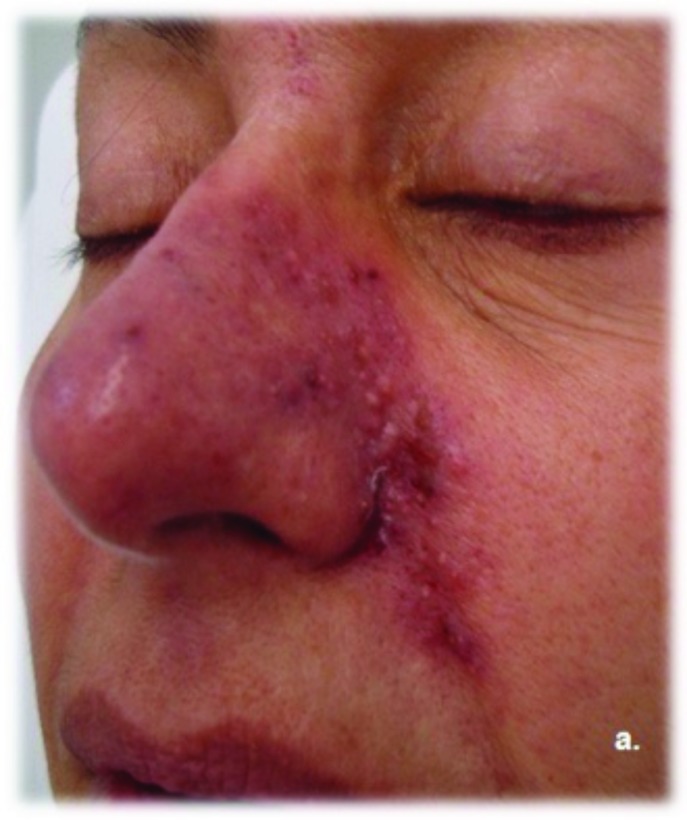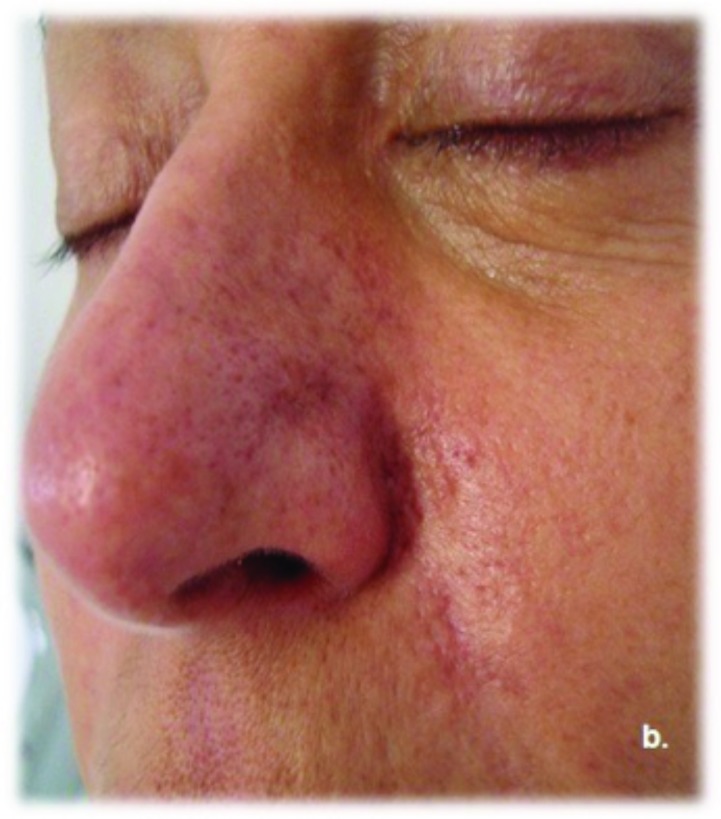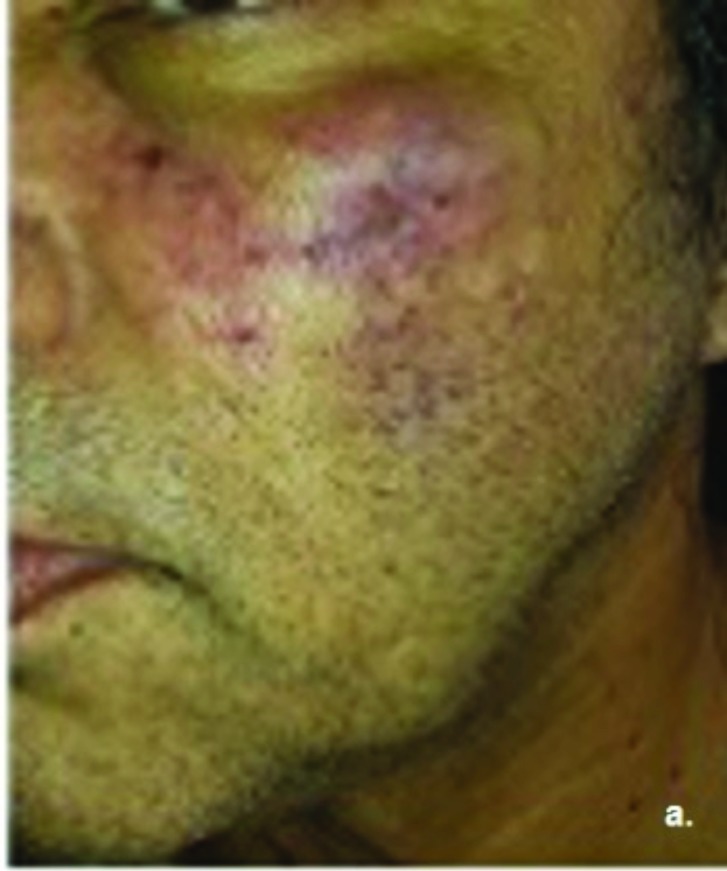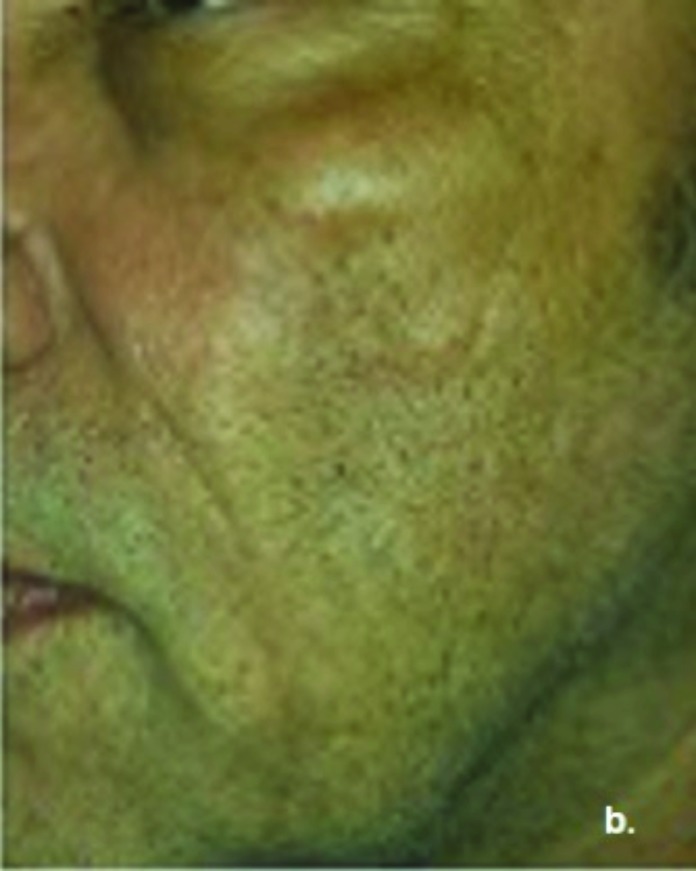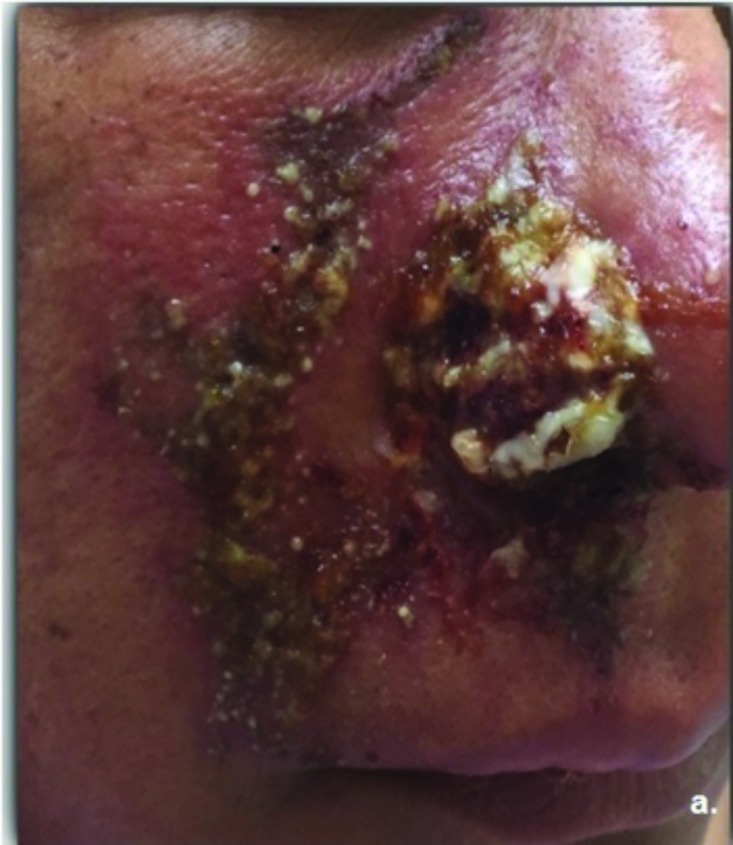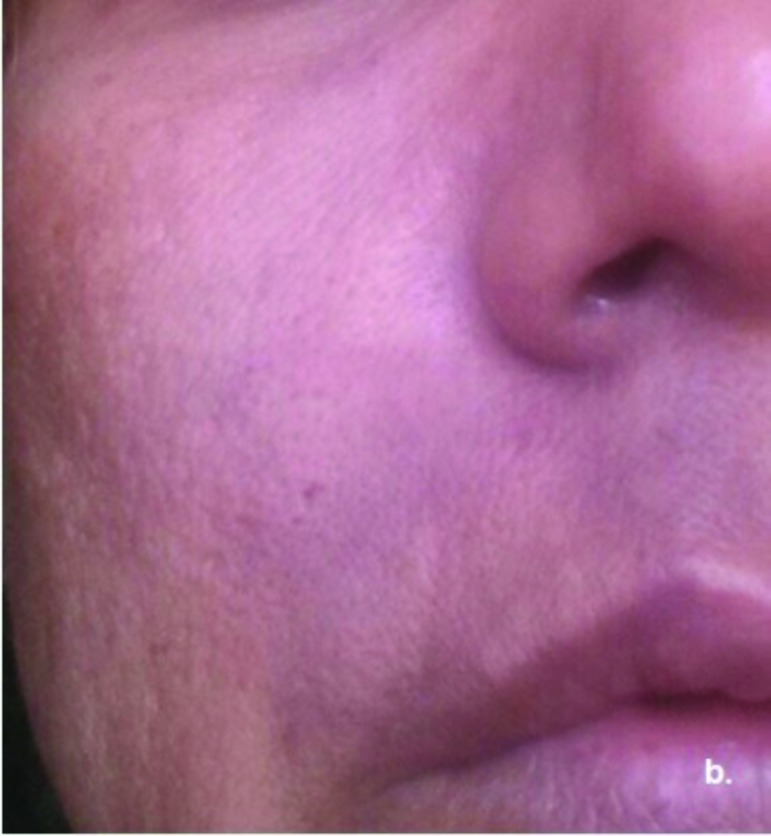Abstract
The growing use of dermal fillers, specifically the use of hyaluronic acid, can be explained by their effectiveness and versatility as well as their favorable safety profiles. Nevertheless, early and late complications with varying levels of severity may occur. The incidence of complications is low and the majority of adverse events are mild (edema, erythema, and local ecchymosis) and of limited duration. However, more severe events, such as ischemia and necrosis, may occur. The symptoms of ischemia can occur immediately after the injection or several hours after the procedure. Here, the authors report three cases of necrosis after hyaluronic acid injection with the first symptoms presenting only several hours after the procedure. The patients were treated immediately after the diagnosis. The aim of this review is to communicate the possibility of the delayed-type presentation of necrosis, present the signs and symptoms that lead to early diagnosis, and review the treatment possibilities of this severe complication.
Dermal fillers have been injected with increasing frequency over the past three decades for soft-tissue augmentation by volume expansion in the management of the aging face. In 2012, there were about two million procedures using dermal fillers, according to the American Society of Plastic Surgeons, five percent more than in 2011 and 205 percent more than in 2000, second only to botulinum toxin type A. These minimally invasive and nonsurgical cosmetic procedures were the two most commonly performed in this range of time studied.1,2
The growing use of dermal fillers, specifically the use of hyaluronic acid (HA), can be explained by their effectiveness and versatility as well as their favorable safety profiles. Nevertheless, early and late complications with varying levels of severity may occur. The incidence of complications is low and the majority of adverse events are mild (edema, erythema, and local ecchymosis) and of limited duration. However, more severe events, such as ischemia and necrosis, may occur.
Injection necrosis is a rare, but important, complication associated with dermal fillers. Necrosis can be attributed to one of two factors—an interruption of vascular supply due to compression or frank obstruction of vessels by direct injection of the material into a vessel itself. The glabella is the injection site commonly believed to be at greater risk for necrosis, but it can also occur at the nasolabial fold.3 Risk factors for intravascular injection include site of application (deep injection of filler products at or near the site of named vessels), volume applied (larger amounts of product can cause a proportionally greater degree of arterial obstruction), and previous scarring (deep tissue scars may stabilize and fix arteries in place, making them easier to penetrate with small sharp needles).4
The initial presentation of vascular events may include pain and discomfort disproportionate to what is typically experienced following filler treatments and clinical findings, including blanching, livedo pattern, or violaceous discoloration.4 Although many cases report this immediate post-injection presentation as the typical background seen in a necrosis event, there are few reports with the first symptom presenting only hours after augmentation. See Figures 1 through 3, where the authors present three cases of vascular compromise after soft-tissue augmentation with delayed-type presentation.
Figures 2Aand 2B.
Case 2: Necrosis and secondary infection 48 hours after the HA injection (a). Discrete scars in the affected area after treatment (b).
Figures 1Aand 1B.
Case 1: Edema, erythema, and progressive violaceous reticulated patch, livedoid area were observed on the left cheek 36 hours after the injection (a). Complete healing five days after hyaluronidase application and nine days after the HA injection (b).
Figures 3Aand 3B.
Case 3: Necrosis and secondary infection 48 hours after the HA injection (a). Erythema, hipercromia, and discreet scars in the affected area after treatment (b).
DISCUSSION
Every aesthetic procedure has its limitations and potential risks, and every aging face is unique. Certain regions of the face are at a higher risk for complications due to critical structures and the vascular system. Having a sound understanding of how facial aging influences the position of structures that lie beneath the skin, knowing the specific techniques to administer each dermal filler and volume enhancer, being well-versed in anatomical locations of critical vessels, knowing which specific “danger zones” to avoid, and knowing what to do if complications occur form the basis to ensure safe and optimal clinical outcomes with augmentation procedures.5-7
The most severe and feared early occurring complication associated with the use of dermal fillers and volume enhancers is arterial/venous occlusion, which leads to ischemia, with subsequent necrosis of the skin and/or vision loss. It can be considered a dermatologic emergency and must be dealt with immediately.5-9 In general, the sooner treatment is given, the better.4 Even if the clinical symptoms do not present immediately, the treatment is imperative and can minimize damage, similar to what happened in the cases presented herein.
Occlusion results from direct intravascular injection of product, vascular injury, or external compression of the blood supply by surrounding filler/volume enhancer material or swelling.3,10,11 The glabella has been the most common site of necrosis reported after soft-tissue augmentation injections. Small vessels branching from the supratrochlear and supraorbital arteries provide the blood supply to the glabellar region and the collateral circulation is limited.12,13 The nasolabial fold is another important site and a popular area treated in the office. Care should be exercised when injecting near the alar groove because large volumes of material or direct injection into the vessel can lead to obstruction of the angular artery and cause necrosis of the nasal ala, which has limited collateral circulation.14-16 The authors present a third area to keep in mind—the infraorbital and zygomaticofacial foramen. It is very important to take inventory of prior facial surgeries and the history and location of other soft tissue fillers and volume, considering that those can alter the patient’s baseline anatomy and result in unpredictable vascular events.5 Furthermore, confounding variables are common. As more clinicians adopt fillers compounded with local anesthetics and epinephrine, they may confuse the clinical picture and hide symptoms. Therefore, the immediate picture must be assessed as well as the progression of the signs and symptoms, with the objective of learning to recognize the adverse events early enough to circumvent sequelae of vascular obstruction.4
TABLE 1.
Case summaries: Filler complications, management, and outcomes
| Case 1 (Figure 1) | Case 2 (Figure 2) | Case 3 (Figure 3) | |
|---|---|---|---|
| Patient | 61-year-old man | 61-year-old woman | 52-year-old woman |
| Product | HA 17.5mg/mL | HA 26mg/mL | HA 20mg/mL |
| Indication | Correction of deep crateriform acne scars | Correction of nasolabial fold | Correction of nasolabial fold |
| Location of injection | Left zygomatic area | Right nasolabial fold | Right nasolabial fold |
| Technique | Micro-bolus injection with 31G needle | Retroinjection with 27G needle | Retroinjection with 27G needle |
| Time of onset post-injection | 36 hours after the injection | 6 hours after the injection | 15 hours after the injection |
| Clinical presentation | Pain, violaceous reticulated patch, livedoid area with approximately 5x8cm with exulceration and thin crust | Pain, violaceous discoloration | Pain, purple to redness area and tender to palpation |
| Artery involved | Zygomaticofacial artery | Angular artery | Angular artery |
| Management | Hyaluronidase 160 Ul oral acetylsalicylic acid 100mg 8/8 hours for five days | Hyaluronidase total 500UI
Use of warm compresses Systemic antibiotics (amoxicillin clavulanate 500mg/125mg 8/8hrs) for 7 days Acetylsalicylic acid 300mg 8/8hrs for 7 days Prednisone 60mg/day for 7 days Hyperbaric oxygen therapy for 7 days |
Hyaluronidase 225UI ciprofloxacin 500mg 12/12h Clopidogrel 300mg initial dose and 75mg daily Sildenafil one pill daily Use of warm compresses During hospitalization:
|
| Outcome | Complete resolution | Discrete atrophic scar | Erythema, hipercromia, and discreet scars in the affected area |
Vessel embolization of filler begins with immediate changes visible in the vascular system—initial blanching, followed by mottled discoloration called livedo reticularis. This is accompanied by pain, unless there is a nerve block or local anesthetic blocking the pain pathways. The resulting ischemia produces a dusky discoloration associated with sluggish or absent capillary refill after digital compression, as well as possible loss of function.4 Therefore, pain out of proportion in terms of severity or persistence after the treatment should be further investigated.3,13,17 The immediate post-injection appearance of discoloration is the typical presentation of vascular ischemia after filler injection, even though there are few reports on necrosis with the first symptom presenting only several hours after the procedure occurred. The three patients in the cases presented had delayed-type presentation. None of them complained of symptoms or showed signs of ischemia during the filler injection or on the day of the procedure. The authors raised the hypothesis of an embolus after the injection and poor collateral circulation to supply nutrition to the area, resulting in late necrosis.9,12 Rare cases of visual impairment and blindness resulting from injection in the glabellar region are described. It may result from retrograde flow of intravascular injected material into the ophthalmic artery, obstructing the blood flow of distal branches that supply the retina and cornea. Clinically, patients may present with a sudden blind spot or visual field deficit.4-6
Physicians can take certain measures to minimize the risk of local necrosis and embolization from injecting dermal fillers by doing the following3:
- Always aspirate before injecting with needle and draw back on the plunger to be assured that the needle tip is not located within a vessel.3
- Avoid using anesthesia near a vascular bundle that may induce vascular spasm, such as those containing epinephrine; also avoid using epinephrine so that the cause of blanching can be determined quickly.5
- Avoid overcorrection as higher filler volumes in a small area can cause compression of adjacent vessels by exceeding the intravascular pressure.3
- Use a microcannula blunt tip, which reduces the risks of intravascular injection of the substance and of disrupting key structures, such as vessels and nerves.18,15
- Use a temporary and biodegradable product (i.e., HA), as it has hyaluronidase to quickly break down and remove some of the product.5,15
In the event of arterial/venous occlusion and impending necrosis, the goal is to quickly promote increased blood flow to the affected area, so treatment should commence without delay, especially if visual access is affected. In the presence of immediate pain or skin discoloration, stop the injection. The area should be massaged, followed by application of hot/warm water gauze and topical 2% nitroglycerin paste to stimulate quick vasodilation to restore blood supply. The topical nitroglycerin paste can be applied as frequently as every 1 to 2 hours initially. The authors have used 300mg aspirin under the tongue immediately and lOOmg daily thereafter as an antiplatelet agent.22-23 In severe cases, low-molecular-weight heparin and systemic anticoagulation may be helpful. Prostaglandin E1 (PGE1) has also been a clinical treatment to promote vasodilation. Systemic treatment is usually done in the hospital with the patient carefully monitored, as with all potent vasoactive drugs.14 Even if patient presentation is delayed, treatment is still recommended because it may restore normal circulation and speed the healing process, as occurred with the authors’ patients.3-9-13-20-22
In the case of HA use, the first step and gold standard is hyaluronidase injection. Hyaluronidase is a soluble and naturally occurring protein enzyme that hydrolyzes both natural and cross-linked HA dermal fillers.20,24,25 The off-label introduction of hyluronidase has proven to be very helpful in the management of many of the complications that may arise from the injection of HA-based dermal fillers.22 Based on different publications and in the authors’ experience, the authors agree that hyaluronidase is the greatest pillar in the treatment of vascular occlusion. It may be injected directly into the affected site, with doses of 40U (0. lmL) or more per cm2, and starts to dissolve the material immediately and lasts for between 24 and 48 hours.12,25,26 Adverse reactions are uncommon and when reported are most frequently local injection-site reactions. Hypersensitivity reaction to hyaluronidase, such as angioedema, rarely occurs. There are no reported anaphylactic reactions after subepidermal injections.12,24,26 Skin testing is sometimes recommended before the use of this enzyme, although it may be impractical in the case of impending skin necrosis.9 Hyaluronidase is contraindicated in patients allergic to bee stings.28-31 It should not be injected into or around an infected or inflamed area because of the potential danger of spreading a localized infection. The optimal time of injection in the case of HA vascular complications has not been determined, but it is wise to use it as early as possible.14 Therefore, keeping at least one bottle of hyaluronidase on site if performing similar procedures is recommended. If ophthalmic artery necrosis is suspected, the authors recommend immediately contacting an oculoplastic colleague or ophthalmic anesthesiologist because they will typically have hyaluronidase on hand, as it has been used in the dispersion of local anesthetics for retrobulbar blocks associated with ophthalmologic surgery. Localized skin breakdown should be treated with topical (with or without systemic) antibiotics, and antivirals should be used especially if necrosis is around the mouth.5,12,13,24
The use of hyperbaric oxygen therapy (HBOT) can be considered in cases of impending massive skin necrosis. HBOT is United States Food and Drug Administration (FDA) approved for necrotizing soft tissue infections and chronic, non-healing wounds. Although the utility of HBOT in the case of vascular compromise due to cosmetic dermal injection has not been explored, two of the authors’ patients with massive necrosis had complementary treatment with HBOT. It can improve the aesthetic outcome in some cases, but some authors do not feel that the cost, risks, and inconvenience of this treatment is warranted.9,21,25
Finally, once necrosis has occurred, it is important to minimize scarring by providing careful wound care with daily dressings. Keeping the wound covered with ointment to prevent crusting and keeping out bacteria until healing is complete is important. Treatment of the resulting scar involves silicone pads and intralesional steroid injection. If a scar remains, it may be treated with light dermabrasion, surgical revision, or injection with filler to restore the contour. A minimum of three months before surgical attempts at scar revision should be allowed for scar maturation and establishment of collateral circulation.3,5,9,25
CONCLUSION
As the use of dermal fillers for soft-tissue augmentation has increased, the number of cases reporting adverse reactions has also increased. Adverse reactions to dermal fillers are considered rare, and knowledge of the therapy in these cases is limited. There is no consensus about the best treatment, and each treatment option has its advantages and disadvantages. The most severe and feared early occurring complication associated with the use of dermal fillers is vascular occlusion. Thus, it is very important that physicians are aware of the anatomy of the treated region, type of product used, application technique, and possible adverse events, so if an adverse event occurs, they can immediately recognize and treat it. Additionally, hyaluronidase is an extremely effective treatment for vascular adverse events after soft-tissue augmentation; therefore, those who use dermal fillers should be familiar with its application.
Footnotes
Author disclosures:The authors report no relevant conflicts of interest.
REFERENCES
- 1.Duranti F, Salti G, Bovani B, et al. Injectable hyaluronic acid gel for soft tissue augmenta-tion. A clinical and histological study. Dermatol Surg. 1998;24:1317–1325. doi: 10.1111/j.1524-4725.1998.tb00007.x. [DOI] [PubMed] [Google Scholar]
- 2.American Society of Plastic Surgeons. http://www.plastic-surgery.org/news/plastic-surgery-statistics/2012-plastic-surgery-statistics.html 2012 plastic surgery procedural statistics. [Cited 2014 Jul 20].
- 3.Glaich AS, Cohen JL, Goldberg LH. Injection necrosis of the glabella: protocol for preven-tion and treatment after use of dermal fillers. Dermatol Surg. 2006;32:276–281. doi: 10.1111/j.1524-4725.2006.32052.x. [DOI] [PubMed] [Google Scholar]
- 4.DeLorenzi C. Complications of injectable fillers, part 2: vascular complications. Aesthetic Surg J. doi: 10.1177/1090820X14525035. 1 April 2014 [Epub ahead of print], [DOI] [PubMed] [Google Scholar]
- 5.Brennan C. Avoiding the “danger zones” when injecting dermal fillers and volume enhancers. Plast Surg Nurs. 2014;34(3):108–111. doi: 10.1097/PSN.0000000000000053. [DOI] [PubMed] [Google Scholar]
- 6.Cohen JL. Understanding, avoiding and managing dermal filler complications. Dermatol Surg. 2008;34:92–99. doi: 10.1111/j.1524-4725.2008.34249.x. [DOI] [PubMed] [Google Scholar]
- 7.Cohen JL, Brown MR. Anatomic considerations for soft tissue augmentation of the face. J Drugs Dermatol. 2009;8:13–16. [PubMed] [Google Scholar]
- 8.Bailey SH, Cohen JL, Kenkel JM. Etiology, prevention and treatment of dermal filler complications. Aesthetic Surg J. 2011;31:110–121. doi: 10.1177/1090820X10391083. [DOI] [PubMed] [Google Scholar]
- 9.Grunebaum LD, Elsaie ML, Kaufman JY. Six-month, double-blind, randomized, split-face study to compare the efficacy and safety of calcium hydroxylapatite (CaHA) mixed with li-docaine and CaHA alone for correction of nasolabial fold wrinkles. Dermatol Surg. 2008;36:760–765. [Google Scholar]
- 10.Cox SE. Clinical experience with filler complications. Dermatol Surg. 2009;35(2):1661–1666. doi: 10.1111/j.1524-4725.2009.01345.x. [DOI] [PubMed] [Google Scholar]
- 11.Ozturk CN, Li Y, Tung R, et al. Complications following injection of soft-tissue fillers. Aesthet Surg J. 2013;33(6):862–877. doi: 10.1177/1090820X13493638. [DOI] [PubMed] [Google Scholar]
- 12.Hirsch RJ, Cohen JL, Carruthers JD. Successful management of an unusual presentation of impending necrosis following a hyaluronic acid injection embolus and a proposed algorithm for management with hyaluronidase. Dermatol Surg. 2007;33:357–360. doi: 10.1111/j.1524-4725.2007.33073.x. [DOI] [PubMed] [Google Scholar]
- 13.Sclafani AP, Fagien S. Treatment of injectable soft tissue filler complications. Dermatol Surg. 2009;35(2):1672–1680. doi: 10.1111/j.1524-4725.2009.01346.x. [DOI] [PubMed] [Google Scholar]
- 14.Kim DW, Yoon ES, Ji YH, et al. Vascular complications of hyaluronic acid fillers and the role of hyaluronidase in management. J Plast Reconstr Aesthet Surg. 2011;64(12):1590–1595. doi: 10.1016/j.bjps.2011.07.013. [DOI] [PubMed] [Google Scholar]
- 15.Sánchez-Carpintero I, Candelas D, Ruiz-Rodriguez R. Dermal fillers: types, indications, and complications. Actas Dermosifiliogr. 2010;101(5):381–393. doi: 10.1016/s1578-2190(10)70660-0. [DOI] [PubMed] [Google Scholar]
- 16.Inoue K, Sato K, Matsumoto D, et al. Arterial embolization and skin necrosis of the nasal ala following injection of dermal fillers. Plast Reconstr Surg. 2008;121:127e–128e. doi: 10.1097/01.prs.0000300188.82515.7f. [DOI] [PubMed] [Google Scholar]
- 17.Park TH, Seo SW, Kim JK, Chang CH. Clinical experience with hyaluronic acid-filler com-plications. J Plast Reconstr Aesthet Surg. 2011;64(7):892–896. doi: 10.1016/j.bjps.2011.01.008. [DOI] [PubMed] [Google Scholar]
- 18.Braz AV, Mukamal LV. Lip filling with microcannulas. Surg Cosmet Dermatol. 2011;(3):257–260. [Google Scholar]
- 19.Coimbra DDA. Filling of the orbital inferior area and nasojugal groove with low concentra-tion hyaluronic acid: a new application technique. Surg Cosmet Dermatol. 2010;(2):67–70. [Google Scholar]
- 20.Kleydman K, Cohen JL, Marmur E. Nitroglycerin: a review of its use in the treatment of vascular occlusion after soft tissue augmentation. Dermatol Surg. 2012;38:1889–1897. doi: 10.1111/dsu.12001. [DOI] [PubMed] [Google Scholar]
- 21.Banh K. Facial ischemia after hyaluronic acid injection. J EmergMed. 2013;44(1):169–170. doi: 10.1016/j.jemermed.2011.06.014. [DOI] [PubMed] [Google Scholar]
- 22.Beleznay K, Humphrey S, Carruthers JD, Carruthers A. Vascular compromise from soft tissue augmentation: experience with 12 cases and recommendations for optimal outcomes. J Clin Aesthet Dermatol. 2014;7(9):37–43. [PMC free article] [PubMed] [Google Scholar]
- 23.Beer K, Downie J, Beer J. Treatment protocol for vascular occlusion from particulate soft tissue augmentation. J Clin Aesthet Dermatol. 2012;5(5):44–47. [PMC free article] [PubMed] [Google Scholar]
- 24.Balassiano LKA, Bravo BSF. Hyaluronidase: a necessity for any dermatologist applying injectable hyaluronic acid. Surg Cosmet Dermatol. 2014;6(4):338–343. [Google Scholar]
- 25.DeLorenzi C. Complications of injectable fillers, part I. Aesthetic Surg J. 2013;33(4):561–575. doi: 10.1177/1090820X13484492. [DOI] [PubMed] [Google Scholar]
- 26.Lee A, Grummer SE, Kriegel D, Marmur E. Hyaluronidase. Dermatol Surg. 2010;36(7):1071–1077. doi: 10.1111/j.1524-4725.2010.01585.x. [DOI] [PubMed] [Google Scholar]
- 27.Kassir R, Kolluru A, Kassir M. Extensive necrosis after injection of hyaluronic acid filler: case report and review of the literature. J Cosmet Dermatol. 2011;10(3):224–231. doi: 10.1111/j.1473-2165.2011.00562.x. [DOI] [PubMed] [Google Scholar]
- 28.Muller UR. Hymenoptera venom proteins and peptides for diagnosis and treatment of ven-om allergic patients. Inftamm Allergy Drug Targets. 2011;10:420–428. doi: 10.2174/187152811797200704. [DOI] [PubMed] [Google Scholar]
- 29.Lyall DA, McQueen M, Ramaesh K, Weir C. A sting in the tale: cross reaction hypersensi-tivity to hyaluronidase. Eye (London). 2012;26(11):1490. doi: 10.1038/eye.2012.167. [DOI] [PMC free article] [PubMed] [Google Scholar]
- 30.Ebo DG, Goossens S, Opsomer F, et al. Flow-assisted diagnosis of anaphylaxis to hyaluronidase. Allergy. 2005;60(10):1333–1334. doi: 10.1111/j.1398-9995.2005.00891.x. [DOI] [PubMed] [Google Scholar]
- 31.Lee HK, Choi EJ, Lee PB, Nahm FS. Anaphylactic shock caused by the epiduraUy-administered hyalurinidase. Korean J Pain. 2011;24(4):221–225. doi: 10.3344/kjp.2011.24.4.221. [DOI] [PMC free article] [PubMed] [Google Scholar]



